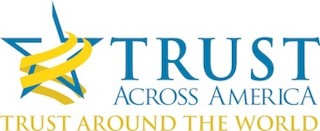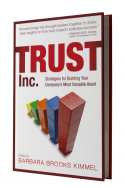Building organizational trust requires leadership “buy-in.” The payoff includes a happier and more stable work force; faster decision making and innovation; and long-term sustainability and profitability.
This list compiles some of the myths surrounding organizational trust and leadership.
- Trust is “soft” and does not increase profitability.
- If an organization complies with the law, it is trustworthy.
- Leaders need not have integrity in their personal life as long as they act the part at work.
- Writing a corporate values statement or having a credo is a waste of time and resources.
- Building trust into the corporate DNA will not result in faster crisis recovery.
- Short-term profitability trumps long-term trustworthiness.
- It’s not leader’s job to ensure that trust-building is an organizational priority.
- Shareholders are more important than other stakeholders.
- Corporate responsibility need not extend beyond philanthropy.
- It’s okay to tell an occasional lie.
What myths would you add to this list? Leave a comment.
These myths and other are discussed in our new book, Trust Inc. Strategies for Building Your Company’s Most Valuable Asset.




Great list. Thank you.
Some other myths to consider:
> There can only be one leader. (A trust-filled organization unleashes many leaders who step up and lead different activities at different times.)
> Leadership is lonely. (Yes, at times some tough decisions are lonely calls, but in a trust-filled organization, leaders are connected to others and a fine consensus often emerges that is superior to any one individual’s thoughts.)
>Leaders meet everyone’s expectations and care for all. (As Harvard’s Marty Linsky says, sometimes leaders must lower the expectations of the group and get rid of toxic performers. Trust goes up as a result.)
Thank you Bob for adding to our list of myths!
The first one really resonates. A trustworthy leader unleashes many more trustworthy leaders.
Enjoyed this excellent list Barbara. A few additional organizational myths come to mind:
> If the CEO says it, it will be so.
Kumbaya only works in Girl Scouts. www.compliancestrategists.org/wp-content/uploads/2012/09/SCCE.Kumbaya.Boehme.pdf Culture and trust building is hard work and requires dedicated, focused, self-aware leadership. That’s why I’ve put “Tone at the Top” on my banned list until more CEOs understand it is not the same as “Tone from my Mouth.” bit.ly/1kSIiJ2 A great CEO who walks the talk is fantastic, but not enough and, let’s face it, uncommon. The best thing a CEO can do in the “walk” category is to establish an independent, empowered chief compliance officer to lead (coach?) the development of ethical leadership in an organization. bit.ly/1al91vV
> The job of the Board is to hire the “right” CEO and then get out of the way.
That’s so 20 years ago. According to a recent Booz Allen survey, CEOs in operational companies last an average of 4.7 years. CEOs leave, Boards stay. The Board needs to ask the right questions and oversee culture proactively. Creating the right incentives for senior leadership is one of the most powerful things Boards can demand. What gets measured is what gets done. Not too many CEOs and C-Suites get up in the morning and say “Hey, let’s tie our compensation and bonuses to ethical leadership metrics as well as financial performance.” That’s where the Board can come in. A series of RAND Symposia over the last 6 years addresses this point. Here’s the latest www.rand.org/pubs/conf_proceedings/CF316.html
Keep up the outstanding work! #TrustMatters #CultureTrumpsRules